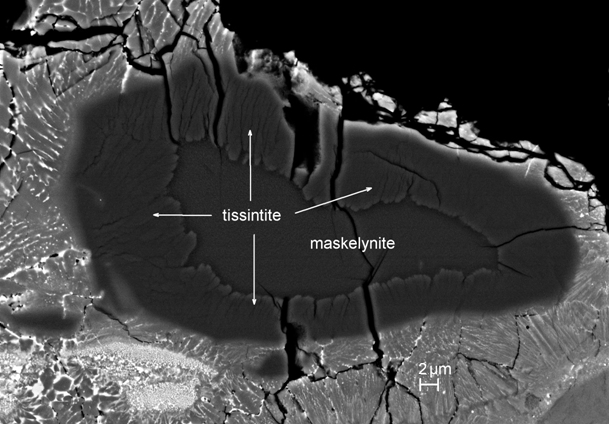Chi Ma1,
Oliver Tschauner2, John R. Beckett1,
Yang Liu3, George R. Rossman1, Kirill Zhuravlev4,
Vitali Prakapenka4, Przemyslaw Dera5, Lawrence A. Taylor6
1Division
of Geological and Planetary Sciences, California Institute of
Technology,
Pasadena, CA 91125, USA2High Pressure Science and Engineering Center and Department of Geoscience, University of Nevada, Las Vegas, Nevada 89154, USA
3Jet Propulsion Laboratory, California Institute of Technology, Pasadena, California 91109, USA
4GSECARS, University of Chicago, Argonne National Laboratory, Argonne Illinois 60439, USA
5Hawai'i Institute of Geophysics and Planetology, University of Hawai'i at Manoa, Honolulu, HI 96822, USA
6Planetary Geosciences Institute, Department of Earth and Planetary Science, University of Tennessee, Knoxville, Tennessee, 37996, USA
Abstract
Tissintite is a new vacancy-rich,
high-pressure clinopyroxene, with a composition essentially equivalent
to plagioclase. It was discovered in maskelynite (shocked plagioclase)
and is commonly observed included within, or in contact with,
shock-melt pockets in the Tissint meteorite, a depleted olivine-phyric
shergottite fall from Mars. The simple composition of tissintite
(An58–69) and its precursor plagioclase (An59–69) together with the
limited occurrence, both spatially (only in maskelynite less than ∼25
μm of a shock melt pocket) and in terms of bulk composition, make
tissintite a “goldilocks” phase. It formed during a shock event severe
enough to allow nucleation and growth of vacancy-rich clinopyroxene
from a melt of not too calcic and not too sodic plagioclase composition
that was neither too hot nor too cold. With experimental calibration,
these limitations on occurrence can be used to place strong constraints
on the thermal history of a shock event. The kinetics for nucleation
and growth of tissintite are probably slower for more-sodic plagioclase
precursors, so tissintite is most likely to occur in depleted
olivine-phyric shergottites like Tissint and other highly shocked
meteorites and lunar and terrestrial rocks that consistently contained
calcic plagioclase precursors in the appropriate compositional range
for a shock of given intensity.
Tissintite, (Ca0.45Na0.31□0.24)(Al0.97Fe0.03Mg0.01)(Si1.80Al0.20)O6, is a C2/cclinopyroxene, containing 42–60 mol% of the Ca-Eskola component, by far the highest known. The cell parameters are a =9.21(17)Å, b =9.09(4) Å, c=5.20(2) Å, β=109.6(9)°, V=410(8) Å3, Z=4. The density is 3.32 g/cm3 and we estimate a cell volume for the Ca-Eskola end-member pyroxene of 411 ±13 Å3, which is consistent with a previous estimate and, therefore, supports the importance of this component in clinopyroxenes from ultra-high pressure metamorphic rocks from the Earth’s upper mantle. At least in C2/c clinopyroxenes as sodic as tissintite, the a-and b-cell parameters as a function of vacancy concentration intersect at ∼0.3 vacancies pfu, much lower than the Ca-Eskola end-member (0.5), an inversion of anisotropy suggesting an elastic instability that drives clinopyroxene toward a disordered trigonal structure closely related to that of wadeite; it may mark the boundary beyond which the breakdown of vacancy-rich clinopyroxene to a wadeite-structured phase + stishovite becomes stable, although this was not observed in Tissint.
Tissintite, (Ca0.45Na0.31□0.24)(Al0.97Fe0.03Mg0.01)(Si1.80Al0.20)O6, is a C2/cclinopyroxene, containing 42–60 mol% of the Ca-Eskola component, by far the highest known. The cell parameters are a =9.21(17)Å, b =9.09(4) Å, c=5.20(2) Å, β=109.6(9)°, V=410(8) Å3, Z=4. The density is 3.32 g/cm3 and we estimate a cell volume for the Ca-Eskola end-member pyroxene of 411 ±13 Å3, which is consistent with a previous estimate and, therefore, supports the importance of this component in clinopyroxenes from ultra-high pressure metamorphic rocks from the Earth’s upper mantle. At least in C2/c clinopyroxenes as sodic as tissintite, the a-and b-cell parameters as a function of vacancy concentration intersect at ∼0.3 vacancies pfu, much lower than the Ca-Eskola end-member (0.5), an inversion of anisotropy suggesting an elastic instability that drives clinopyroxene toward a disordered trigonal structure closely related to that of wadeite; it may mark the boundary beyond which the breakdown of vacancy-rich clinopyroxene to a wadeite-structured phase + stishovite becomes stable, although this was not observed in Tissint.

Tissintite in a section of the Tissint meteorite
Revised 27-Apr-2015